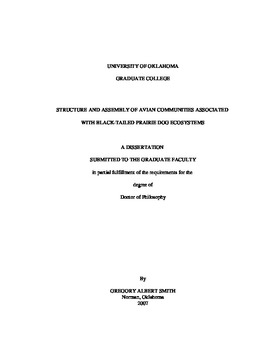| dc.contributor.advisor | Lomolino, Mark V., | en_US |
| dc.contributor.advisor | Matthews, William J., | en_US |
| dc.contributor.author | Smith, Gregory Albert. | en_US |
| dc.date.accessioned | 2013-08-16T12:20:37Z | |
| dc.date.available | 2013-08-16T12:20:37Z | |
| dc.date.issued | 2007 | en_US |
| dc.identifier.uri | https://hdl.handle.net/11244/1180 | |
| dc.description.abstract | It is clear that even in their current remnant state, black-tailed prairie dogs continue to play a significant role in the assembly of ecological communities across the Great Plains. Conservation of prairie dogs goes well beyond a single species, and is an important strategy for the preservation of the prairie ecosystem as a whole. | en_US |
| dc.description.abstract | I tested the hypothesis that black-tailed prairie dogs influence avian community structure on the shortgrass prairie and essentially function as ''islands'' in a sea of grass. I surveyed 36 prairie dog towns and 36 paired sites without prairie dogs during summer and fall of 1997, 1998, and 1999 in the Oklahoma Panhandle. Surveys totaled 9,040 individual observations for 73 avian species. Significantly distinct avian communities were present on prairie dog towns when compared to sites within four different macrohabitats of the surrounding landscape: open rangeland, scrub/sandsage (Artemisia filifolia) habitats, Conservation Reserve Program (CRP) plots, and fallow crop fields. Relative densities of all bird species combined was higher on prairie dog towns versus paired sites in summer and fall. Mean species richness of birds was significantly higher on prairie dog towns than paired sites during summer, but there were no significant differences in fall. Assemblages of avian communities differed significantly between prairie dog towns and the four macrohabitat types during summer. | en_US |
| dc.description.abstract | Burrowing owls (Athene cunicularia), killdeer ( Charadrius vociferous), horned larks (Eremophila alpestris ), and meadowlarks (Sturnella spp.) were positively and significantly associated with prairie dog towns during summer, while horned larks and ferruginous hawks (Buteo regalis) were significantly associated with prairie dog towns during fall. Richness was not significantly associated with town size or isolation. Richness was however associated with certain local habitat characteristics (percentage of forb coverage) and certain landscape-level variables (area of scrub habitat within 10 km of a focal town). Birds also show a strong geographic trend in richness, increasing significantly from west to east. These results are consistent with the emerging view that communities on relatively small islands are strongly influenced by characteristics of the surrounding landscape, variables other than area and isolation. | en_US |
| dc.description.abstract | I examined avian communities on the shortgrass plains and tested for associations with black-tailed prairie dog (Cynomys ludovicianus) towns. The black-tailed prairie dog is one of five members of the genus Cynomys (Order Rodentia, Family Sciuridae) and is the only prairie dog species occurring in Oklahoma. Prairie dogs create and maintain a unique habitat by keeping vegetation clipped low to the ground and by construction of extensive, underground tunnel systems. Other species use dog towns as foraging sites, use burrows as dens or refugia from predators or severe weather, or use prairie dogs themselves as prey. Black-tailed prairie dogs have maintained a broad and relatively stable geographic range since the end of the Pleistocene and may have once covered from 40-100 million hectares. Today, they cover less than 5% of this area. The remaining towns are increasingly smaller, fragmented, and more isolated. | en_US |
| dc.format.extent | xviii, 163 leaves : | en_US |
| dc.subject | Grassland ecology Oklahoma. | en_US |
| dc.subject | Bird communities Oklahoma. | en_US |
| dc.subject | Biology, Ecology. | en_US |
| dc.subject | Black-tailed prairie dog Oklahoma. | en_US |
| dc.subject | Biology, Zoology. | en_US |
| dc.title | Structure and assembly of avian communities associated with black-tailed prairie dog ecosystems. | en_US |
| dc.type | Thesis | en_US |
| dc.thesis.degree | Ph.D. | en_US |
| dc.thesis.degreeDiscipline | Department of Biology | en_US |
| dc.note | Source: Dissertation Abstracts International, Volume: 68-04, Section: B, page: 2039. | en_US |
| dc.note | Advisers: Mark V. Lomolino; William J. Matthews. | en_US |
| ou.identifier | (UMI)AAI3261103 | en_US |
| ou.group | College of Arts and Sciences::Department of Biology | |
